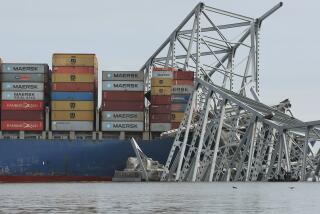Offramp Crash Cushions Are Making an Impact on Safety : City Smart / How to thrive in the urban environment of Southern California
- Share via
Moments when high school physics ruins the fun: The scene in “Speed” in which a speeding Jaguar caroms off the freeway and into a bank of water-filled plastic crash cushions. No way, amateur students of Newton might figure as the passenger on screen jumps from the car with fist a-shaking.
While the ubiquitous yellow barrels--called attenuators by the poets at Caltrans--do in fact lessen the consequences of a car smashing into the concrete barrier that separates offramps from the far right lane of traffic, the laws of physics dictate that the impact will still be severe.
“Attenuators are designed to cushion a vehicle to a stop,” said Caltrans spokesman Jim Drago. “But that doesn’t necessarily mean you will walk away.”
You might live, though.
Crash cushions were developed during the 1950s and 1960s as the nation took to the ever-evolving interstates in ever greater numbers. More drivers on high-speed highways meant more people dying as they introduced their Chevys grill-first to freeway abutments.
One of the first efforts to develop crash cushions came from Detroit car makers. They toyed with the notion of water-filled bumpers.
“Those tests didn’t really pan out,” Drago said. “Then the Feds got involved and said, ‘Let’s take a look at this.’ ”
The result: Federally funded researchers in Texas suggested placing empty 55-gallon steel drums at strategic points to absorb the impact of crashes. Texas is one of the few states that still use the empty cans.
“They’re not very aesthetic,” said Richard Powers, an engineer with the Federal Highway Administration. “But they have proven quite effective.”
Variations appeared after a racing accident in which a car smashed through a barrier and killed 80 spectators. John Fitch, a friend of the dead driver, started experimenting with boxes and bags of sand. Eventually, the state of New York installed sand-filled barrels based on Fitch’s design along turnpikes.
The technology didn’t come to California until the 1970s, when Caltrans installed the barrels along several freeways in Los Angeles. Puzzled motorists were baffled by the sand-filled cushions, which looked like garbage cans.
“When we put them out originally, we took pictures to see how people reacted,” Drago said. “Some people tried to pry the lids off. One person dumped their garbage in one. Someone else stabbed some with a knife.”
Statewide, there are more than 1,000 crash cushions at “gore points”--as traffic engineers call them, for their shape--the triangular zones on freeways where offramps veer away and are separated from the main road by concrete barriers. Most of the attenuators used in California are filled with sand, although a few contain water.
The way attenuators work is through a relatively simple redistribution of energy. As high school physics teaches, the momentum of an object is equal to its velocity times its mass. The job of a crash cushion is to dissipate that forward energy.
In the case of the Texas barrels, the forward energy of the car is transferred to the crushing of the barrels, which are arrayed like bowling pins and get progressively stiffer as they near the gore point or bridge piling. That progressive resistance enables the car to be more slowly cushioned to a stop.
Otherwise, Powers said, the cushions wouldn’t be much use, because if the first barrel in an array is too stiff, the impact might be as severe as hitting the road obstruction outright. Remember, passengers inside the car will not stop moving forward until they hit a solid object, most likely the windshield or dashboard. Softer initial barrels mean that impact will be as low as possible. In the same way, if the barrels closer to the concrete barrier are not stiff enough, they will do little to stop the car.
Sand barrels, which are most common on California roadways, employ many of the same principles, but put them into practice a little differently. The barrels themselves--which stand three feet tall and are about three feet in diameter--are plastic and not all that sturdy. Even a glancing blow can wreck one.
The sand provides the cushioning. As in Texas, the sand barrels are set up in different configurations, depending on the thickness of the barrier they are protecting against. Barrels in the front contain less sand. Barrels in the back hold more.
When a car hits the barrels, the forward momentum is dispersed throughout the sand, slowing the car to a safer--though hardly gentle--stop. “It should be a survivable impact,” Powers said, noting that the cushions are tested with cars weighing from 1,800 to 4,500 pounds moving 62 mph.
And although passengers and cars may survive the impact, the attenuators rarely do. That’s why cost-conscious engineers are excited about a new cushion being tested in Arkansas made of polyethylene cylinders that act like giant bumpers to bounce cars away from hazards. After crashes, the cylinders themselves bounce back into shape.
Just like that driver in “Speed.”





